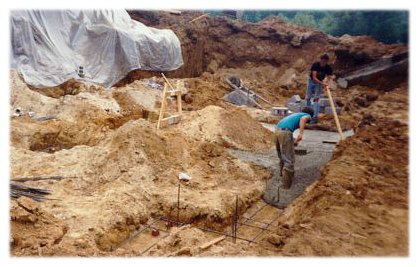
These footings have been excavated with a backhoe and cleaned up with shovels to the proper depth. Steel reinforcing rods have been installed in the bottom third of the excavation and supported with pieces of brick. Additional pieces of re-bar have been driven into the ground, checked with a transit, and are being used as depth guides to determine the correct height for the top of the finished concrete.
As you can see, the footings are formed by the the sides of the excavation, so the cost of purchasing wooden form material and the cost of the labor to install it has been eliminated. Considerably less stone will be needed under the slab using this method as well.
You can also see the downside of this method of pouring footings; the piles of dirt that need to be removed after the concrete cures. Because the footings are formed into the ground, it will also be necessary to dig channels for the interior drain tile and radon mitigation system. Another thing to consider is the likelihood that mud will cover the footings and your wall layout pins should it rain before you finish the first course of concrete block. Pumping out muddy water and shoveling soggy soil off of hundreds of feet of concrete are not the most enjoyable ways of spending one's time.
So, which method of pouring footings is right for your job? You will need to consider the options and the cost involved with each in order to make an informed decision that works best for your project.